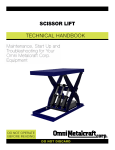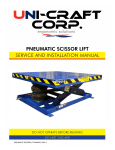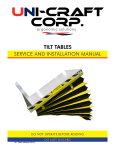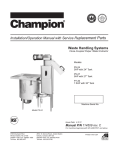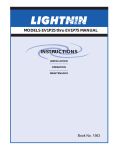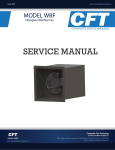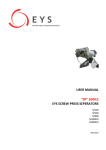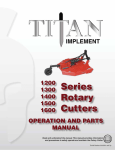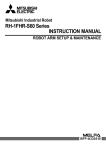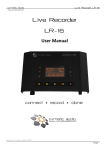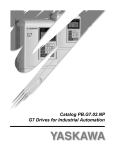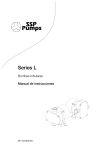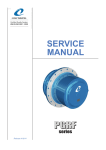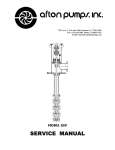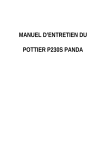Download Turntable Technical Handbook
Transcript
1 TURNTABLE TECHNICAL HANDBOOK 2012.1 TURNTABLE TECHNICAL HANDBOOK 2012.1 TURNTABLE TECH HANDBOOK TABLE OF CONTENTS TABLE OF CONTENTS .................................................................................................................................. 2 GENERAL SAFETY STATEMENTS .................................................................................................................. 3 -Introduction ..................................................................................................................................................... 3 -Cautions, Warnings and Hazards ..................................................................................................................... 3 SAFETY INFORMATION ............................................................................................................................... 4 -General Safety Labels....................................................................................................................................... 4, 5 -Installation Safety ............................................................................................................................................ 6 -Electrical Safety ................................................................................................................................................ 7 -Operational Safety ........................................................................................................................................... 8 -Maintenance and Service Safety...................................................................................................................... 9, 10 RECEIVING AND INSPECTION ...................................................................................................................... 11 -Returns, Damages and Shortages ................................................................................................................... 11 -Removal of Crating .......................................................................................................................................... 11 GENERAL INSTALLATION ............................................................................................................................ 12 -Installation Instructions ................................................................................................................................... 12 -Operating Instructions ..................................................................................................................................... 13 LEG SUPPORTS AND INSTALLATION............................................................................................................ 14 -Leg Adjustments .............................................................................................................................................. 14 OPTIONAL EQUIPMENT .............................................................................................................................. 15 -Torque Limiters ................................................................................................................................................ 15-17 -Additional Options ........................................................................................................................................... 18 PRE-START-UP OVERVIEW .......................................................................................................................... 19 -Preparing for Initial Start-Up ........................................................................................................................... 19 -Drive Chain and Sprocket Alignment ............................................................................................................... 20 -Drive Chain and Sprocket Tension ................................................................................................................... 21 -Gear Reducer Vent Plug ................................................................................................................................... 21 -Inspection and Lubrication .............................................................................................................................. 22 MAINTENANCE ........................................................................................................................................... 23 -Maintenance Schedules ................................................................................................................................... 23 -Report on Miscellaneous Maintenance Performed ......................................................................................... 24 TROUBLESHOOTING AND REPLACEMENT PARTS ........................................................................................ 25 -Troubleshooting ............................................................................................................................................... 25 PARTS LISTS ................................................................................................................................................ 26 -Low Profile Manual Turntable (LPMT) ............................................................................................................. 26 -Roller Turn Roller Turntable ............................................................................................................................ 27 -Rotary Bearing Turntable ................................................................................................................................. 28 NOTES ........................................................................................................................................................ 29 WARRANTY ................................................................................................................................................ 30 2 TURNTABLE TECHNICAL HANDBOOK 2012.1 TURNTABLE TECH HANDBOOK GENERAL SAFETY STATEMENTS IMPORTANT ¡IMPORTANTE! REQUIRED READING! ¡LECTURA OBLIGATORIA! To ensure this quality product is safely and correctly utilized, all instructions within this manual must be read and understood prior to equipment start-up. Be aware of all safety labels on machinery. If you do not understand any of the safety instructions or feel there may be safety labels missing, contact your supervisor or product supplier immediately! Para garantizar que este producto de calidad se utilice correctamente y con seguridad, es necesario leer y comprender las instrucciones incluidas en este manual, antes de comenzar a utilizar el equipo. Esté atento a todas las etiquetas de seguridad que se encuentran en las máquinas. Si no entiende alguna de las instrucciones de seguridad o considera que faltan algunas etiquetas de seguridad, ¡comuníquese inmediatamente con su supervisor o proveedor del producto! COMPLIANCE WITH SAFETY STANDARDS Compliance with safety standards, including federal, state and local codes or regulations is the responsibility of the equipment purchaser(s). Placement of guards, safety labels and other safety equipment is dependent upon the area and use to which the system is applied. A safety study should be made of the equipment application by the purchaser(s). It is the purchaser’s responsibility to provide any additional guards, safety labels or other safety equipment deemed necessary based on this safety study. The information contained in this safety manual is correct at the time of printing. Due to the continuing development of product lines, changes in specifications are inevitable. The company reserves the right to implement such changes without prior notice. If you suspect fire hazards, safety hazards, dangers towards health or any other job safety concerns, consult your federal, state or local codes. Certain safety information in this document was reprinted from ASME B20.1-2000 by permission of The American Society of Mechanical Engineers. All rights reserved. Inspect equipment for safety labels. Make sure personnel are aware of and follow safety instructions. Maintain an orderly environment in the vicinity of the equipment at all times. Clean up spilled materials or lubricants immediately. All personnel shall be instructed regarding the necessity for continuous care and attention to safety during the operation of the equipment. They must be trained to identify and immediately report all unsafe conditions or practices relating to the equipment and its operation. Know your company’s machine specific Lockout / Tagout procedure. Do Not perform maintenance until electrical disconnect has been turned off! Replace all safety devices, guards and guarding prior to equipment start-up. References used for safety instructions in this manual are from: Conveyor Equipment Manufacturers Association (CEMA) and The American Society of Mechanical Engineers (ASME) 3 TURNTABLE TECHNICAL HANDBOOK 2012.1 TURNTABLE TECH HANDBOOK SAFETY INFORMATION: GENERAL SAFETY LABELS Safety labels have been placed at various points on the equipment to alert everyone of potential dangers. Inspect equipment for proper position of safety labels and make sure all personnel are aware of the labels and obey their warnings. As mentioned in the previous section, a safety study should be made of the equipment application by the purchaser(s). It is the purchaser’s responsibility to provide any additional guards, safety labels or other safety equipment deemed necessary based on this safety study. The following pages contain typical safety labels that may have been attached to your equipment. #110479 ( 5” x 2 1/2” ) Placed on terminating ends (both ends) where there are exposed moving parts which must be unguarded to facilitate function, i.e. rollers, pulleys, shafts, chains, etc. #113529 (5” X 2 1/2” ) Placed next to drive (both sides) to warn personnel that the lineshaft conveyor utilizes a rotating shaft which may be hazardous if hair or loose clothing become entangled around the rotating shaft. Also used on any other conveyors where the exposed shaft may create similar hazards. #111744 (5” X 2 1/2” ) General warning to personnel that the equipment’s moving parts, which operate unguarded by necessity or function, i.e., air cylinders, etc., create hazards to be avoided. #110478 ( 5” X 2 1/2” ) Placed on all chain guards to warn that operation of the machinery with guards removed would expose chains, belts, gears, shafts, pulleys, couplings, etc. which create hazards. #113513 ( 5” X 2 1/2” ) Placed on chain guard base so label is visible when guard cover is removed. #111752 ( 5” X 2 1/2” ) Placed on max. of 20’ centers (both sides) along turntable which provide surfaces and profiles attractive, but hazardous, for climbing, sitting, walking or riding. #113528 ( 5” X 2 1/2” ) Placed next to drive (both sides) to warn maintenance personnel that turntable/conveyors must be shut off and locked out prior to servicing. Examples: drives, take-ups, and lubrication points, which require guard removal. #111870 ( 5” X 3” ) General warning of pinch point hazards. 4 TURNTABLE TECHNICAL HANDBOOK 2012.1 (Continued on next page) TURNTABLE TECH HANDBOOK SAFETY INFORMATION: GENERAL SAFETY LABELS (Continued) #111750 ( 1 3/4” x 1 1/4” ) Generally placed on smaller guards to alert personnel of potential danger if guard is removed and power is not locked out. #111749 ( 3” x 1 1/4” ) Placed on shipping brace which stabilizes equipment during shipping. Brace must be removed before operating! May cause severe injury if not removed. 5 TURNTABLE TECHNICAL HANDBOOK 2012.1 #110491 (10” x 7” ) Placed on equipment where turntables/conveyor may start without warning. TURNTABLE TECH HANDBOOK SAFETY INFORMATION: INSTALLATION SAFETY 1) LOADING / UNLOADING Have trained personnel load or unload equipment. The equipment must be properly handled when transferring from the unloading area to final site location to prevent damage. 2) GUARDS / GUARDING Interfacing of Equipment. When two or more pieces of equipment are interfaced, special attention shall be given to the interfaced area to ensure the presence of adequate guarding and safety devices. Guarding Exceptions. Wherever conditions prevail that would require guarding under this standard but such guarding would render the equipment unusable, seek guidance from your safety professional. 3) ANCHORING DO NOT operate equipment unless it is properly anchored. Serious injury or death may result. 4) SAFETY WARNING Install all safety devices, guards and guarding prior to equipment start-up. 6 TURNTABLE TECHNICAL HANDBOOK 2012.1 TURNTABLE TECH HANDBOOK SAFETY INFORMATION: ELECTRICAL SAFETY 1) ELECTRICAL CODE All electrical installations and wiring shall conform to federal, state and local codes. When equipment operation is not required for a maintenance procedure, electrical power must be turned off and locked / tagged out following your company’s machine specific procedure. 2) CONTROL STATION Control stations should be so arranged and located that the operation of the affected equipment is visible from them. Control stations shall be clearly marked or labeled to indicate the function controlled. Equipment that would cause injury when started shall not be started until personnel in the area are alerted by a signal or by a designated person that the equipment is about to start. Where system function would be seriously hindered or adversely affected by the required time delay, or where the intent of the warning may be misinterpreted (i.e., a work area with many different equipment and allied devices), a clear, concise and legible warning sign needs to be provided. The warning sign shall indicate that equipment and allied equipment may be started at any time, that danger exists and that personnel must keep clear. These warning signs shall be provided along the equipment at areas not guarded by position or location. Remotely and automatically controlled equipment, and equipment where operator stations are not manned or are beyond voice or visual contact from drive areas, loading areas, transfer points and other potentially hazardous locations on the equipment path not guarded by location, position or guards shall be furnished with emergency stop buttons, pull cords, limit switches or similar emergency stop devices. All such emergency stop devices shall be easily identifiable in the immediate vicinity of such locations unless guarded by location, position or guards. Where the design, function and operation of such equipment clearly is not hazardous to personnel, an emergency stop device is not required. The emergency stop device shall act directly on the control of the equipment concerned and shall not depend on the stopping of any other equipment. The emergency stop devices shall be installed so that they cannot be overridden from other locations. Inactive and unused actuators, controllers and wiring should be removed from control stations and panel board, together with obsolete diagrams, indicators, control labels and other material that might confuse the operator. 3) SAFETY DEVICES All safety devices, including wiring of electrical safety devices, shall be arranged to operate such that a power failure or failure of the device itself will not result in a hazardous condition. 4) EMERGENCY STOPS AND RESTARTS Equipment controls shall be so arranged that, in case of emergency stop, manual reset or start at the location where the emergency stop was initiated shall be required for the equipment and associated equipment to resume operation. Before restarting the equipment that has been stopped because of an emergency, an inspection of the equipment shall be made and the cause of the stoppage determined. The starting device and electrical power must be turned off and locked / tagged out according to your company’s machine specific procedure before any attempt is made to remove the cause of the stoppage, unless operation is necessary to determine the cause or to safely remove the stoppage. 5) SAFETY WARNING Replace all safety devices, guards and guarding prior to equipment start-up. 7 TURNTABLE TECHNICAL HANDBOOK 2012.1 TURNTABLE TECH HANDBOOK SAFETY INFORMATION: OPERATIONAL SAFETY Only trained, qualified personnel shall be permitted to operate the equipment. Training shall include instruction in operation under normal conditions and emergency situations. Where safety is dependent upon stopping / starting devices, they shall be kept free of obstructions to permit access. The area around loading and unloading points shall be kept clear of obstructions that could endanger personnel. Do not ride the load-carrying element of a conveyor/equipment under any circumstances, unless the equipment is designed and equipped with safety and control devices intended to carry personnel. For no reason shall a person ride any element of a vertical conveyor. Warning labels reading “DO NOT RIDE CONVEYOR” shall be affixed by the owner of the equipment. Personnel working on or near a conveyor/equipment shall be instructed as to the location and operation of pertinent stopping devices. Equipment shall be used to transport only a load that it is designed to handle safely. Under no circumstances shall the safety characteristics of the equipment be altered. Routine inspections and preventative and corrective maintenance programs shall be conducted to ensure that all safety features and guards are retained and function properly. Inspect equipment for safety labels. Make sure personnel are aware of and follow safety label instructions. Alert all personnel to the potential hazard of entanglement in conveyors/equipment caused by items such as long hair, loose clothing and jewelry. SAFETY WARNING Replace all safety devices, guards and guarding prior to equipment start-up. 8 TURNTABLE TECHNICAL HANDBOOK 2012.1 TURNTABLE TECH HANDBOOK SAFETY INFORMATION: MAINTENANCE / SERVICE SAFETY ELECTRICAL POWER MUST BE TURNED OFF AND LOCKED / TAGGED OU T following your company’s machine specific procedures when servicing equipment to prevent accidental restarting by other persons or interconnecting equipment (when used). 1) MAINTENANCE (REPAIR) Maintenance and service shall be performed by trained, qualified personnel only. Where lack of maintenance and service would cause a hazardous condition, the user shall establish a maintenance program to ensure that turntable/conveyor components are maintained in a condition that does not constitute a hazard to personnel. No maintenance or service shall be performed when a turntable/conveyor is in operation. See “Lubrication” and “Adjustment or Maintenance During Operation” for exceptions. When a turntable/conveyor is stopped for maintenance or service, the starting devices, prime mover, powered accessories or electrical must be locked / tagged out in accordance with a formalized procedure designed to protect all persons or groups involved with the turntable/conveyor against an unexpected restart. Personnel should be alerted to the hazard of stored energy, which may exist after the power source is locked out. All safety devices and guards shall be replaced before starting equipment for normal operation. 2) ADJUSTMENT OR MAINTENANCE DURING OPERATION When adjustments or maintenance must be done while equipment is in operation, only trained, qualified personnel who are aware of the hazards of the turntable/conveyor in motion shall be allowed to make adjustments, perform maintenance or service. Turntable/conveyors shall NOT be maintained or serviced while in operation unless proper maintenance or service requires the turntable/conveyor to be in motion. If turntable/conveyor operation is required, personnel shall be made aware of the hazards and how the task may be safely accomplished. 3) LUBRICATION Turntable/conveyors shall NOT be lubricated while in operation unless it is impractical to shut them down for lubrication. Only trained and qualified personnel who are aware of the hazards of the turntable/conveyor in motion shall be allowed to lubricate a turntable/conveyor that is operating. Where the drip of lubricants or process liquids on the floor constitutes a hazard, drip pans or other means of eliminating the hazard must be provided by purchaser(s). 4) MAINTENANCE OF GUARDS AND SAFETY DEVICES Guards and safety devices shall be maintained in a serviceable and operational condition. Warning signs are the responsibility of the owner of the turntable/conveyor and must be maintained in a legible / operational condition. 9 TURNTABLE TECHNICAL HANDBOOK 2012.1 TURNTABLE TECH HANDBOOK SAFETY INFORMATION: MAINTENANCE / SERVICE SAFETY (Continued) 5) INSPECTIONS Routine inspections with preventative and /or corrective maintenance programs shall be conducted to ensure that all safety features and devices are maintained and function properly. All personnel shall inspect for hazardous conditions at all times. Remove sharp edges or protruding objects. Repair or replace worn or damaged parts immediately. 6) CLEANING Where light cleaning and/or casing cleaning are required, they shall be performed by trained personnel. The turntable/conveyor electrical power must be turned off and locked / tagged out following your company’s machine specific procedures. Special attention may be required at feed and discharge points. 7) SAFETY WARNING Replace all safety devices, guards and guarding prior to equipment start-up. 10 TURNTABLE TECHNICAL HANDBOOK 2012.1 TURNTABLE TECH HANDBOOK RECEIVING AND INSPECTION: RETURNS, DAMAGES AND SHORTAGES UNCRATING CHECKLIST 1) Compare the bill of lading with what you have received (including accessories). 2) Examine the equipment for damage. 3) Immediately report shortages or damages to the vendor and carrier. 4) Obtain a signed damage report from the carrier and send a copy to the vendor. Do not attempt to modify or repair damaged equipment prior to filing this report. Note: Do not return equipment to the factory without a written return authorization. Returns without written authorization will not be accepted. Note: Custom products may be crated differently. MOTOR DRIVEN ROLLER CONVEYOR STRAIGHT AND CURVE TECH HANDBOOK RECEIVING AND INSPECTION: REMOVAL OF CRATING AFTER COMPLETING THE “UNCRATING CHECKLIST” 1) Remove crating and packaging. 2) Look for boxes, accessories, bags or components such as fasteners, manuals, guard rails etc. that may be banded or fastened to the crating material. Note: Make sure all fasteners, guards and essential components are not discarded. 11 TURNTABLE TECHNICAL HANDBOOK 2012.1 TURNTABLE TECH HANDBOOK GENERAL INSTALLATION: INSTALLATION INSTRUCTIONS 1) Turntables are shipped on either skids or pallets. With slings placed around the base frame, remove the unit from the skid. Be careful not to damage any of the frame structure. DO NOT LIFT THE UNIT BY THE TOP PLATE OR ANY ATTACHED EQUIPMENT! 2) Position the unit keeping the entire “swing diameter” clear. (If equipped with mounted conveyor, check conveyor alignment with stationary conveyors.) 3) For turntables with legs, see the “Leg Supports and Installation” page for leg adjustment procedure. 4) Instruct user(s) in the proper operation of the turntable, safety precautions and equipment capacity. Supply maintenance personnel with this service manual. 12 TURNTABLE TECHNICAL HANDBOOK 2012.1 TURNTABLE TECH HANDBOOK GENERAL INSTALLATION: OPERATING INSTRUCTIONS PREOPERATIONAL CHECKS 1) Check all electrical wiring and connections to be sure that they are completed properly and are operational. 2) Check for obstructions or debris within the “swing-diameter” that may interfere with the safe operation of the turntable. 3) Be sure that all personnel in the area are a safe distance away from the unit and aware that you are about to operate it. 4) If there are any optional safety devices such as bellows or electric toe guards, check them for proper operation. TEST OPERATE THE EQUIPMENT 1) Station yourself so that you will always see the equipment when it is in operation. 2) Cycle the equipment several times to be sure that it is operating smoothly with no jerking or sudden movement. 3) Test the rotation time of the unit while fully loaded to ensure that the torque limiter is functioning properly. 4) Check all safety devices for proper operation. 13 TURNTABLE TECHNICAL HANDBOOK 2012.1 TURNTABLE TECH HANDBOOK LEG SUPPORTS AND INSTALLATION WELDED LEG ADJUSTMENTS Note: Only qualified installation professionals should level and install conveyor. WELDED LEG ADJUSTMENT: JACK-BOLT 1) The conveyor electrical power must be turned off and locked / tagged out following your company’s machine specific procedures. 2) Remove all load from the conveyor. 3) Position conveyor in the location to be installed. 4) Support conveyor section with jack, hoist or forklift. 5) Carefully loosen the retaining bolt. 6) Carefully loosen the jam nut holding the jack-bolt in position on the jack-bolt plate. 7) Adjust the boot position by turning the jack-bolt. 8) Ensure that the conveyor is completely level. (reference leveling note above) 9) Tighten the jam nut securely against the jack-bolt plate using torque appropriate for each fastener’s size and grade. LEG BOOT (grade 5 fasteners provided) 10) Tighten the retaining bolt using torque appropriate for each fastener’s size and grade. (grade 5 fasteners provided) WELDED LEG ADJUSTMENT: NON-JACK-BOLT 1) The conveyor electrical power must be turned off and locked / tagged out following your company’s machine specific procedures. 2) Remove all load from the conveyor. 3) Position conveyor in the location to be installed. 4) Support conveyor section with jack, hoist or forklift. 5) Carefully loosen the retaining bolt. 6) Lift or lower conveyor until it is at the desired height. 7) Ensure that the conveyor is completely level. (reference leveling note above) 8) Tighten fasteners using torque appropriate for each fastener’s size and grade. (grade 5 fasteners provided) 9) Secure the leg boot to the upright by either of the methods listed below: LEG BOOT A) Weld the boot into place. B) Drill through boot and upright and bolt the boot securely into place. 14 TURNTABLE TECHNICAL HANDBOOK 2012.1 BASE UPRIGHT JACK-BOLT JAM NUT JACK-BOLT PLATE SPREADER FOOT TOP PLATE RETAINING BOLT FOOT PAD BASE UPRIGHT SPREADER RETAINING BOLT FOOT PAD TURNTABLE TECH HANDBOOK OPTIONAL EQUIPMENT: TORQUE LIMITERS Torque limiters protect machinery from damage due to unexpected overload conditions. The driven center member slips on nonasbestos friction discs during extraordinary loads on the driveline. Torque limiters automatically reset when the overload condition is relieved. MODELS 250 AND 350 (350 MODEL SHOWN) MODELS 500 AND 700 (500 MODEL SHOWN) B A C B D PRESSURE PLATE D A C SET SCREW HUB FRICTION DISC ADJUSTING NUT SPRING Dimensions (inches) Torque Ratings (lb - ft) One Spring Min. Max. SPRING RETAINER BUSHING SPRING Model ADJUSTING NUT FRICTION DISC LOCK WASHER Two Springs Min. Max. A B C Min. Max. D Weight (lbs) 250 25 60 30 95 2 1/2 1 3/4 1/8 11/32 5/8 1 350 50 120 60 190 3 1/2 2 3/16 1/8 1/2 3/4 2 500 700 90 200 250 620 120 290 400 900 5 7 2 7/8 3 7/8 1/4 7/16 5/8 3/4 7/8 1 7 17 TORQUE RATINGS The torque ratings are estimates that may be used as a basis for selection and comparison to other products. Actual torque capacity may vary significantly depending upon many factors. The center drive member must be flat and parallel with a proper bore size as described on page 18. The torque limiter should be installed and “run-in” per instructions provided with each shipment. Field conditions such as oil, humidity, water and temperature, as well as the frequency and duration of slippage will affect torque capacity. BORE SIZES Torque limiters have hubs with a wide range of finished bore sizes that are provided with USA standard keyways and one set screw. Hubs with a minimum plain bore are available for each model. Special metric bores and keyways per ISO standard are available upon request. RESTRICTIONS ON USE Torque Limiters were not designed to function as clutches and must not be used to engage or disengage drive systems. They should never be use as personal protection devices. They are best suited for low speed mechanical drive where slippage is infrequent and of short duration. 15 TURNTABLE TECHNICAL HANDBOOK 2012.1 TURNTABLE TECH HANDBOOK OPTIONAL EQUIPMENT: TORQUE LIMITERS TORQUE LIMITER INSTALLATION AND TORQUE ADJUSTMENT INSTRUCTIONS MODELS 500 AND 700 (500 MODEL SHOWN) B PRESSURE PLATE D A C SET SCREW HUB ADJUSTING NUT SCREWS ADJUSTING NUT FRICTION DISC BUSHING SPRING RETAINER SPRING INSTALLATION 1) In addition to the torque limiter, obtain a center member, usually a sprocket. Ensure that it is finished according to the specifications shown in the literature. Select a bushing to fit the bore and width of the center member. 2) Back off the three adjusting nut screws four full turns. 3) Remove the adjusting nut, spring retainer, spring, pressure plate and one friction disc. 4) Ensure that the friction discs are free of oil or moisture. 5) Install the bushing over the hub and pilot the center member over the bushing. Re-assemble the friction disc, pressure plate with the smooth side to the friction disc, spring, spring retainer with pilot facing the spring and the adjusting nut. 6) Advance the adjusting nut to a finger–tight position, ensuring that the spring is piloted on the spring retainer. RUN IN PROCEDURE 1) It is recommended that the unit be “run in” by slipping the center member. 2) Ensure that the three adjusting nut screws are backed off four turns and that the adjusting nut is in a fingertight position. 3) Match mark the adjusting nut and hub. Back off the adjusting nut 1 1/2 turns for the 500 model or 2 1/4 turns for the 700 model. Tighten the three adjusting nut screws alternately until the heads bottom. 4) Slip the center member for 3 to 4 minutes at approximately 50 RPM. 5) Install the torque limiter on the shaft with a key and tighten the set screw in the hub. 16 TURNTABLE TECHNICAL HANDBOOK 2012.1 TURNTABLE TECH HANDBOOK OPTIONAL EQUIPMENT: TORQUE LIMITERS TO ADJUST TORQUE 1) Ensure that the three adjusting nut screws are backed off four full turns and that the adjusting nut is in a finger-tight position. 2) Match mark the adjusting nut with the hub. Back off the adjusting nut the number of turns that correspond to the desired break away torque as shown in the chart below. Model Approximate Break Away Torque 500 1 Spring 90 lb ft 150 lb ft 200 lb ft 250 lb ft max 500 2 Springs 120 lb ft 300 lb ft 350 lb ft 400 lb ft max Turns 1 1/2 1 3/4 0 700 1 Spring 300 lb ft 400 lb ft 530 lb ft 620 lb ft max 700 2 Springs 450 lb ft 600 lb ft 750 lb ft 900 lb ft max Turns 2 1 3/4 1 1/4 0 3) Tighten the three adjusting screws alternately until the heads bottom. 17 TURNTABLE TECHNICAL HANDBOOK 2012.1 TURNTABLE TECH HANDBOOK OPTIONAL EQUIPMENT: ADDITIONAL OPTIONS LIMIT SWITCHES OR PROXIMITY SWITCHES To determine position of table top Acceleration or deceleration timing SLIP RING Route power through center of table to rotating deck of turntable May affect the minimum height of table ROTARY UNION Route air or hydraulic oil to rotating deck of turntable Rotary unions may affect the minimum height of table 250 PSI maximum MOTOR OPTIONS Inverter duty motor, air motor, hydraulic motor GRAVITY TRANSITION ROLLERS Gravity transition rollers are standard on units that incorporate a conveyor deck Gravity transition rollers, which are attached to the rotating part of the turntable, are used to assist in supporting products during the transition from adjoining conveyor to the turntable Powered transition rollers are also available to aid problem products Fixed transition rollers can also be mounted to adjoining conveyor or turntable base DETENTS Spring/non-locking Locking Style Hand release Foot release Custom options available 18 TURNTABLE TECHNICAL HANDBOOK 2012.1 TURNTABLE TECH HANDBOOK PRE-START-UP OVERVIEW: PREPARING FOR INITIAL START-UP 1) 2) 3) 4) 5) 6) 7) 8) Review pages 7 and 8 prior to starting any equipment. Verify that conveyor sections, leg supports, etc. were installed properly. Verify that all roller-to-roller and drive chains and sprockets are installed, aligned, and tensioned properly. Verify that set screws are fastened securely in sprockets, bearings, etc. Check all fastening hardware. Tighten securely. Verify that all motor control wiring is connected properly. Verify that conveyor is not loaded with product. Verify that gearboxes are filled with the proper amount of oil or that they were factory filled with lube. (If your turntable/conveyor is equipped with a Boston 700 Series Reducer, it is filled with oil, sealed and lubed for life thus requiring no oil changes. Literature provided with equipment will give detailed gearbox lube info) 9) Verify that the gearbox has necessary vent plugs installed if applicable. (If your turntable/conveyor is equipped with a Boston 700 Series Reducer, it is supplied with a PosiVent® and no vent plug is required. Literature provided with equipment will give detailed info on gearbox vent plug requirements.) 10) Non Jack-Bolt leg boots are to be welded to leg uprights or bolted in place prior to introduction of product loads. See page 15. 19 TURNTABLE TECHNICAL HANDBOOK 2012.1 TURNTABLE TECH HANDBOOK PRE-START-UP OVERVIEW: DRIVE CHAIN AND SPROCKET ALIGNMENT DRIVE CHAIN AND SPROCKET ALIGNMENT To achieve maximum service life and efficiency from a chain drive, follow these simple guidelines: Visually inspect the roller chain, sprockets, and other components and verify that they are in good condition. Ensure that the sprockets are properly aligned. Adequately lubricate the chain. Inspect for proper chain tension. CONDITION OF COMPONENTS Shafting and bearings should be supported rigidly to maintain the initial alignment. Roller chain should be free of grit and dirt. Wash chain in kerosene when required. Relubricate. DRIVE ALIGNMENT Misalignment results in uneven loading across the width of the chain and may cause roller link-plate and sprocket tooth wear. Drive alignment involves two things: parallel shaft alignment and axial sprocket alignment. ALIGNING SHAFTS Shafts should be parallel and level. If there is axial movement of the shaft (as in the case of an electric motor), lock the shaft in the normal running position before aligning the sprockets. ALIGNING SPROCKETS Sprocket axial alignment can be checked with a straight edge which will extend across the finished sides of the two sprockets. Normally, it is good practice to align the sprockets as close to the shaft bearing as possible. For long center distances, use a taut cord, or wire long enough to extend beyond each of the sprockets. STRAIGHT EDGE SET SCREWS SPROCKET SPROCKET 20 TURNTABLE TECHNICAL HANDBOOK 2012.1 WARNING: Before performing any maintenance, lubrication or inspection on any powered turntable/conveyor, the electrical power must be turned off and locked / tagged out following your company’s machine specific procedure. NEVER operate the turntable/conveyor with any guard removed. TURNTABLE TECH HANDBOOK PRE-START-UP OVERVIEW: DRIVE CHAIN AND SPROCKET TENSION INSTALLING THE CHAIN Recheck all preceding adjustments for alignment and make certain all setscrews, bolts and nuts are tight. Fit chain around both sprockets and bring the free ends together on one sprocket for connection. The sprocket teeth will locate the chain end links. Install the connecting link, connecting link cover plate and the spring clip or cotter pins. On larger pitch chains or heavy multiple strand, it may be necessary to lock the sprockets for this operation. CHAIN TENSION Check chain tension to be certain the slack span has an approximate 2% mid-span movement. CHAIN TOO TIGHT CORRECT SLACK CHAIN TOO LOOSE SPROCKET CENTERS Requires extra power and causes excessive wear Approximately 2% of sprocket centers Causes excessive wear and excessive noise CHAIN DRIVEN LIVE ROLLER CONVEYOR STRAIGHT AND CURVE TECH HANDBOOK PRE-START-UP OVERVIEW: GEAR REDUCER VENT PLUG PosiVent® Omni Metalcraft Corp. standardly supplies the Boston Gear PosiVent® option for all current 700 series styles and configurations. This specially-designed internal pressure equalization system allows the gearbox to operate in all environments without the use of conventional pressure vents. The unique design comes complete with Klubersynth UH1 6-460 lubrication pre-filled for all mounting positions. Unlike competitive versions, this unique single seam design allows for easy installation and extended life. This means longer trouble-free operation with virtually no maintenance. 21 TURNTABLE TECHNICAL HANDBOOK 2012.1 TURNTABLE TECH HANDBOOK PRE-START-UP OVERVIEW: INSPECTION AND LUBRICATION CARE AND MAINTENANCE OF CHAIN Proper maintenance of any chain should include correct lubrication, periodic inspection and proper adjustment for normal wear. Periodic inspection of the chain and sprockets is required to detect any deviation from normal wear before serious damage takes place. The cost of such inspection is repaid many times in extended chain life and in freedom from failure. No general rule can be given for the frequency of inspection. The frequency should be influenced by conditions of operation. CHAIN LUBRICATION AND ENVIRONMENT One of the most important factors in getting the best possible performance out of our drive chain is proper lubrication. A well lubricated chain will have an operating life much longer than that of an unlubricated chain. Wear between the pin and bushing causes drive chain to elongate. These parts should, therefore, be well lubricated. The gap between the roller link plate and the pin link plate on the slack side of the chain should be filled with oil. This oil forms a film which minimizes wear on the pin and bushing, thus increasing the chain’s service life. It also reduces noise and acts as a coolant when the chain runs at high speeds. PIN BUSHING ROLLER PIN LINK PLATE ROLLER LINK PLATE Clean Atmosphere: Chains operating in a relatively clean atmosphere can be lubricated by brush or dripfeed oilers or by applying the lubricant manually with a brush or oil can. Atmosphere with Lint or Non-Abrasive Dust: Where large volumes of lint or non-abrasive dust are present, a brush or wiper can be used to clean the chain and apply a lubricant. Otherwise the lint or dust will clog the chain joint clearance and prevent penetration of the oil into the joints. Abrasive Atmosphere: If abrasives come in contact with chain, lubrication becomes more difficult. When lubricants are applied externally, abrasive particles tend to adhere to the chain surfaces and act as a lapping or grinding compound. Under extreme conditions it is sometimes advisable to avoid chain lubrication. Extreme Conditions: Consult a lubricant manufacturer when chains are required to operate at temperatures outside of those indicated in the chart below or if chains are used in other extreme conditions. SUGGESTED LUBRICATION Only high quality oil should be used to lubricate chain. Neither heavy oil nor grease is suitable. The lubricant should have a viscosity to enable it to reach internal surfaces under normal conditions. Lubricants suggested for specific ambient temperatures and chain speed ranges are given in the table below. TEMPERATURE CHAIN NUMBER 15° - 35° F 35° - 105° F 105° - 120° F 120° - 140° F ANSI 25 - 50 ANSI 60 - 100 ANSI 120 - 240 4" & 6" PITCH (ENGINEERED CHAIN) SAE10W SAE20 SAE30 SAE20 SAE30 SAE40 SAE30 SAE40 SAE40 SAE50 SAE20 SAE30 22 TURNTABLE TECHNICAL HANDBOOK 2012.1 SAE50 SAE40 TURNTABLE TECH HANDBOOK MAINTENANCE: MAINTENANCE SCHEDULES Note: Review pages 9 and 10 prior to maintaining any equipment. If equipment repair or replacement is required during inspections, thoroughly review the manufacturer’s specific product information for correct procedure. DAILY MAINTENANCE Inspect turntable to ensure that all guarding is securely in place. WEEKLY MAINTENANCE Inspect turntable for loose bolts and set screws. Inspect turntable for unusual or excessive noise or heat in bearings, reducers and motors. Inspect turntable drive chain to ensure that it runs freely and without excessive noise. MONTHLY MAINTENANCE Inspect reducers for leaks around seals. If required, check lubrication for proper level or amount. Inspect drive chains and sprockets for wear, alignment and proper chain tension. Inspect all other chains and sprockets for wear and lubricate. For chain lubrication information see page 23. When lubricating drive chain care must be taken not to allow lubricant to come in contact with torque limiter friction disk pads. Grease all roller turn rollers, center bearing and/or rotary bearings. Use a No. 2 lithium grease or equivalent. Brush grease on roller turn roller path after initial break in (1/4 - 1/2” wide groove worn into roller path). Use a No. 2 lithium grease or equivalent. ANNUAL MAINTENANCE Change oil in reducers. (If your turntable is equipped with a Boston 700 Series Reducer, it is filled with oil, sealed and lubed for life thus requiring no oil changes. See manufacturer’s information for recommended lubricant at specific temperatures. This information is shipped with every reducer.) 23 TURNTABLE TECHNICAL HANDBOOK 2012.1 TURNTABLE TECH HANDBOOK MAINTENANCE: REPORT ON MISCELLANEOUS MAINTENANCE PERFORMANCE REPORT ON MISCELLANEOUS MAINTENANCE PERFORMANCE Date___________ Maintenance Performed: ____________________________________________________________________________________________ ____________________________________________________________________________________________ ____________________________________________________________________________________________ Date___________ Maintenance Performed: ____________________________________________________________________________________________ ____________________________________________________________________________________________ ____________________________________________________________________________________________ Date___________ Maintenance Performed: ____________________________________________________________________________________________ ____________________________________________________________________________________________ ____________________________________________________________________________________________ Date___________ Maintenance Performed: ____________________________________________________________________________________________ ____________________________________________________________________________________________ ____________________________________________________________________________________________ Date___________ Maintenance Performed: ____________________________________________________________________________________________ ____________________________________________________________________________________________ ____________________________________________________________________________________________ Date___________ Maintenance Performed: ____________________________________________________________________________________________ ____________________________________________________________________________________________ ____________________________________________________________________________________________ Date___________ Maintenance Performed: ____________________________________________________________________________________________ ____________________________________________________________________________________________ ____________________________________________________________________________________________ 24 TURNTABLE TECHNICAL HANDBOOK 2012.1 TURNTABLE TECH HANDBOOK TROUBLESHOOTING AND REPLACEMENT PARTS: TROUBLESHOOTING PROBLEM CAUSE Motor is overloaded Turntable does not start, rotate or Torque limiter not set motor stalls frequently Excessive drive chain and/or sprocket wear Check circuit breaker Insufficient lubrication Lubricate chain Misaligned sprockets Loose drive chain Defective bearing Loose set screw on drive sprocket Improperly tensioned drive chain Roller turn roller misalignment Insufficiently greased roller turn roller or path Damaged roller turn roller support bracket Overloaded conveyor Low voltage to motor Overheating motor and/or reducer Check for turntable overload Set torque limiter per Torque Limiter instructions on page 16. Motor is drawing excessive current Excessive chain tension Loud popping/grinding noise SOLUTION Insufficient reducer lubrication level Brake motor or independently wired brake not releasing 25 TURNTABLE TECHNICAL HANDBOOK 2012.1 Tension drive chain properly and align drive sprockets Replace bearing Check key and tighten set screw on drive sprocket Tension drive chain and align drive sprockets Align roller turn roller axle with center line of table Grease roller turn roller bearings and/or path Replace roller turn roller support bracket Check for conveyor overload Apply proper voltage Fill reducer lubricant reservoir if applicable Check for proper installation and/ or wiring to brake motor or independently wired brake. TURNTABLE TECH HANDBOOK PARTS LISTS: LOW PROFILE MANUAL TURNTABLE (LPMT) DETAIL 1 2 3 4 5 6 7 8 9 DESCRIPTION TOP PLATE WELDMENT TURNTABLE BASE WELDMENT SLEEVE BEARING CAM FOLLOWER DETENT HEX HEAD CAP SCREW FLAT WASHER LOCK WASHER HEX NUT 26 TURNTABLE TECHNICAL HANDBOOK 2012.1 TURNTABLE TECH HANDBOOK PARTS LISTS: ROLLER TURN ROLLER TURNTABLE DETAIL 1 2 3 4 5 6 7 8 9 10 11 12 13 14 15 DESCRIPTION TURN TABLE BASE WELDMENT TOP PLATE WELDMENT ROLLER SUPPORT WELDMENT ROLLER TURN ROLLER ROLLER BOLT (REGREASEABLE) BEARING SPACER RING IDLER SPROCKET CHAIN GUIDE WEAR STRIP LEFT CORNER CLAMP RIGHT CORNER CLAMP TORQUE LIMITER DRIVE SPROCKET ROLLER CHAIN DETAIL 16 17 18 19 20 21 22 23 24 25 26 27 28 29 30 DESCRIPTION MOTOR DRIVE GUARD REDUCER REDUCER MOUNTING PLATE FOOT WELDMENT LIMIT SWITCH ASSEMBLY LIMIT SWITCH TRIGGER J-BOX BRACKET SLIP RING ANTI-ROTATION BRACKET PIPE NIPPLE JAM NUT HEX HEAD CAP SCREW LOCK WASHER JAM NUT HEX NUT 27 TURNTABLE TECHNICAL HANDBOOK 2012.1 TURNTABLE TECH HANDBOOK PARTS LISTS: ROTARY BEARING TURNTABLE DETAIL 1 2 3 4 5 6 7 8 9 10 11 12 13 14 DESCRIPTION DETAIL TURN TABLE BASE WELDMENT 15 TOP PLATE WELDMENT 16 YOKE ROLLER ASSEMBLY (OPTIONAL) 17 CHAIN GUIDE WELDMENT 18 BEARING (ROTARY) 19 IDLER SPROCKET 20 FOOT WELDMENT 21 REDUCER PLATE 22 TORQUE LIMITER 23 DRIVE SPROCKET 24 ROLLER CHAIN 25 REDUCER 26 BRAKE 27 MOTOR DESCRIPTION BOTTOM CHAIN GUARD TOP CHAIN GUARD WEAR STRIP RIGHT CORNER CLAMP LEFT CORNER CLAMP BUMPER BRACKET WELDMENT RUBBER BUMPER PROX BRACKET SPACER SHIM HEX HEAD CAP SCREW LOCK WASHER HEX NUT 28 TURNTABLE TECHNICAL HANDBOOK 2012.1 TURNTABLE TECH HANDBOOK NOTES Notes: ___________________________________________________ ___________________________________________________ ___________________________________________________ ___________________________________________________ ___________________________________________________ ___________________________________________________ ___________________________________________________ ___________________________________________________ ___________________________________________________ ___________________________________________________ ___________________________________________________ ___________________________________________________ ___________________________________________________ ___________________________________________________ ___________________________________________________ ___________________________________________________ ___________________________________________________ ___________________________________________________ ___________________________________________________ ___________________________________________________ ___________________________________________________ ___________________________________________________ ___________________________________________________ ___________________________________________________ ___________________________________________________ ___________________________________________________ ___________________________________________________ ___________________________________________________ ___________________________________________________ ___________________________________________________ ___________________________________________________ ___________________________________________________ ___________________________________________________ ___________________________________________________ ___________________________________________________ ___________________________________________________ 29 TURNTABLE TECHNICAL HANDBOOK 2012.1 TURNTABLE TECH HANDBOOK ABBREVIATED WARRANTY Omni Metalcraft Corp. warrants that the Equipment will be free of defects in workmanship and material (if properly installed, operated and maintained) for a period of one year or 2080 hours of use, whichever is sooner, from date of shipment to Customer, subject to the limitations hereunder set forth. If within the one year warranty period, Omni receives from the Customer written notice of any alleged defects in the Equipment and if the Equipment is not found to be in conformity with this warranty (the Customer having provided Omni a reasonable opportunity to perform any appropriate tests thereon) Omni will, at its option, either repair the Equipment or supply a replacement therefore. *The above stated information is in reference to a section of Omni Metalcraft’s full Terms and Conditions of sale. This information does not constitute an agreement, but simply reference information. To obtain a full copy of Omni Metalcraft’s Terms and Conditions of sale, please contact your sales representative. 30 TURNTABLE TECHNICAL HANDBOOK 2012.1 31 TURNTABLE TECHNICAL HANDBOOK 2012.1































